Choosing the Right Tongs for Non-Stick Pans
Intro
When it comes to cooking with non-stick pans, having the right utensils can make all the difference. Tongs, in particular, pose as a pivotal kitchen tool, ensuring that delicate dishes maintain their integrity while you toss, flip, or serve. This guide will navigate you through the essential aspects of selecting and utilizing tongs specifically tailored for non-stick cookware.
Far too often, cooks overlook the connection between utensil quality and cooking satisfaction. The nuanced grip of a perfected pair of tongs can elevate a simple dish into a memorable experience. Today’s kitchen enthusiasts understand that both efficiency and care for their tools are of paramount importance. Without further ado, let’s dive into the design trends that are shaping the landscape of tongs for non-stick pans.
Design Trends
Innovative Materials
The materials chosen for tongs can impact not just performance but also the longevity of non-stick pans. While traditional metal tongs can scratch or damage non-stick coatings, silicone tongs have gained popularity. Silicone is heat-resistant and gentle on non-stick surfaces, making it a favorite among chefs and home cooks alike. Tongs made from a combination of stainless steel and silicone also offer durability without compromising the coat.
Ergonomic Designs
The rise of ergonomic designs in kitchen tools cannot be ignored. Tongs with comfortable grips take into account prolonged use, especially during large family meals or gatherings. Handles that are designed to fit naturally in the hand help reduce strain, allowing for effortless flipping and tossing. Features such as locking mechanisms for easy storage are an added testament to modern designs that cater to both usability and function.
"In the kitchen, using the right tools not only elevates the dish but also enhances your cooking experience."
Aesthetic Appeal
Tongs are no longer just functional items; they are becoming an essential part of kitchen aesthetics. Colorful silicone options and sleek stainless designs that blend seamlessly with modern kitchen themes are gaining traction. Homeowners are not hesitating to showcase their tongs next to their non-stick pans, making them a part of the kitchen’s visual identity.
Practicality Meets Trends
Trends are crucial, but practicality should lead the way in decision-making. It’s vital to assess how a design serves beyond aesthetics. Would new ergonomic shapes provide better control? Or do vibrant colors distract during heated moments of culinary creativity? With every trend, consider how it affects both the cooking process and your interaction with the pans.
As we move forward, let's explore the buying guides that can equip you with the knowledge necessary to choose the right tongs for your needs.
Prelims to Tongs and Non-Stick Cookware
Navigating the world of kitchen tools often feels like venturing into a maze filled with endless choices. Tongs, albeit a simple tool, hold significant power in the culinary setting, especially when paired with non-stick pans. Understanding their role is essential for anyone who appreciates the craft of cooking, be it a seasoned chef or a weekend enthusiast.
Understanding Non-Stick Coating
Non-stick cookware has revolutionized home cooking. The idea of being able to fry up some eggs or flip pancakes without the hassle of food sticking to the bottom of the pan is undeniably appealing. The magic lies in the non-stick coating, typically made from substances like polytetrafluoroethylene (PTFE) or ceramic.
However, not all coatings are made equal. Some models can handle higher temperatures, while others might wear down if subjected to aggressive utensils. Here’s where your choice of tongs comes into play. It’s crucial to select tongs that won’t scratch your non-stick surfaces, preserving the integrity of the coating and ensuring your cooking remains hassle-free.
The Role of Tongs in Cuisine
Tongs are indeed more than meets the eye, providing both practical function and finesse in the kitchen. From flipping meats on the grill to serving spaghetti with grace, their versatility cannot be understated. With the right pair of tongs, one can achieve precision without compromising that precious non-stick surface.
Consider this: When stirring or flipping food in non-stick pans, you'll want a tool that offers both grip and caution. Traditional metal tongs might be suitable for heavier cookware, but for delicate non-stick surfaces, a gentler option like silicone would do the trick.
"Using the right pair of tongs is not just about cooking; it's about enhancing the overall culinary experience."
In addition to protecting your pans, tongs that can withstand high heat without melting or warping become an essential part of your toolkit. Thus, understanding the chemistry of non-stick coatings, coupled with the selection of appropriate tongs, is a recipe for kitchen success.
The Importance of Choosing the Right Tongs
Selecting the appropriate tongs for non-stick pans is not a mere triviality; it's crucial to your culinary success. Without the right tools, cooking techniques can falter, flavors may diminish, and an evening's meal can rapidly turn into a kitchen disaster. The role of tongs in managing heat and delicate ingredients is paramount, especially when working with non-stick surfaces that warrant gentle handling.
When combined with appropriate design and material choices, the right tongs become what seasoned cooks would call an extension of their hands. Grippy, easy-to-use tongs can make the difference between a smooth cooking session and one fraught with slippery mishaps.
Material Considerations
Silicone
Silicone tongs offer a soft touch, making them a popular pick for non-stick cookware. Their heat resistance allows them to withstand high temperatures without melting or warping. Unlike metal options, silicone tongs won't scratch your pan's surface, keeping it intact and increasing its lifespan. The flexibility of silicone also gives you a decent grip on various food items, whether it be flipping pancakes or tossing salad greens. However, one might note that silicone can be less durable compared to some metal alternatives, and it can attract grease and grime more easily.
Wood
Wooden tongs carry a certain charm that some cooks find appealing. They are typically sturdy and resistant to heat, making them less likely to bend compared to their plastic counterparts. Furthermore, wood is gentle enough on non-stick surfaces, ensuring it won’t create scratches. A unique characteristic of wood is its natural insulation, which means you won’t burn your hands even if the tongs are heated. However, wooden tongs can absorb moisture and odor, which may require careful cleaning and maintenance to preserve their quality over time.

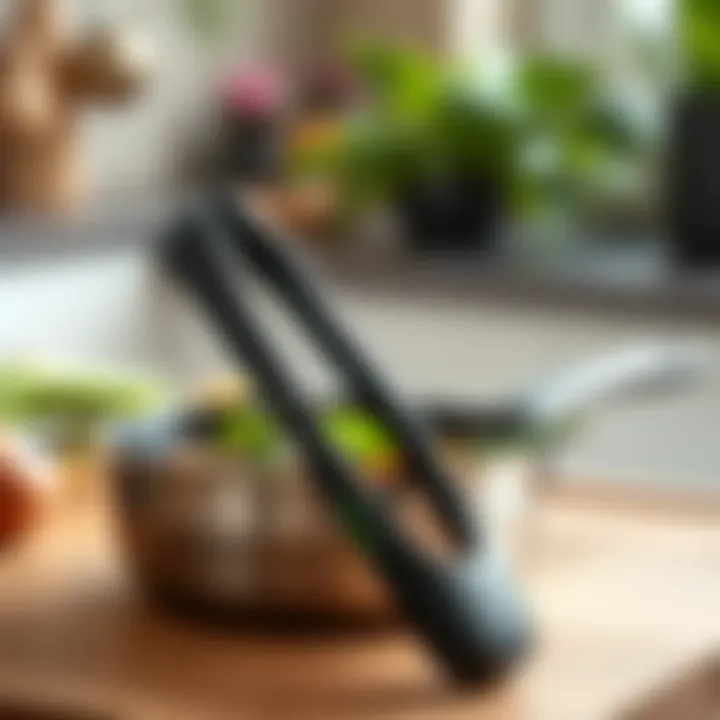
Plastic
Plastic tongs are known for their affordability and lightweight nature. They come in a variety of colors, making them visually appealing to some. While they are generally safe to use on non-stick pans, care must be taken to ensure they are heat resistant. Many plastic tongs will buckle under high temperatures, potentially causing a melting hazard. So when choosing plastic tongs, it's key to ensure they are specifically designed for high-heat cooking.
Metal
Metal tongs, particularly stainless steel models, are often lauded for their strength and durability. They generally won’t break or bend easily and offer excellent precision in handling food. However, metal tongs pose a higher risk of scratching non-stick surfaces, so caution is advised. The cold, hard metal can be unyielding, particularly for delicate items; that’s where careful maneuvering and technique come into play. Their ability to handle high temperatures is a plus, but the trade-off often involves a consideration around their abrasive nature on non-stick cookware.
Grip and Functionality
Ergonomic Design
Ergonomic design plays a pivotal role in the overall experience of using tongs. A well-designed pair of tongs will fit comfortably in your hand, reducing strain and making cooking feel less laborious. Features like rubber grips can enhance comfort, while spring-loaded mechanisms make it easy to open and close the tongs with little effort. A common pitfall with poorly designed tongs is that users often struggle with trying to control them, leading to dropped food or spills. Investing in ergonomics is not just about comfort; it can greatly influence cooking performance.
Ease of Use
When it comes to general cooking, ease of use cannot be overstated. Tongs should operate smoothly and allow for quick maneuvers, whether you're flipping burgers or serving pasta. Look for tongs with a locking mechanism that can easily secure the tongs for storage. This not only saves space but keeps your kitchen neat. If you find yourself wrestling with tongs during a busy cooking session, the experience can quickly turn frustrating. A simple, intuitive design can help you focus on what matters—creating a fantastic meal.
Types of Tongs for Non-Stick Pans
The right tongs can make all the difference when it comes to cooking with non-stick pans. Selecting the proper type is key not only for maintaining the integrity of your cookware but also for enhancing your overall cooking experience. Different tongs serve unique functions, and understanding these can lead you to make more informed decisions. Your choice can impact everything from how you handle delicate ingredients to how effectively you can flip or turn food while minimizing any potential scratches or damage to the non-stick surface.
Curling Tongs
Curling tongs are specially designed with a curved shape that is great for grasping and turning food. These tongs often come with soft, heat-resistant grips to ensure a safe hold on hot items. This type of tongs is particularly advantageous for flipping pancakes or serving pasta, where a gentle grasp allows the food to maintain its form. The curved design also accommodates the rounded edges of many non-stick pans, helping prevent scraping. When using curling tongs, keep an eye on their temperature resistance to ensure they won't warp with high heat.
Tip: Always choose curling tongs made from silicone to avoid damaging your non-stick surface!
Slimline Tongs
Slimline tongs are a favorite among home cooks who appreciate precision. Their narrow design makes them ideal for tasks that require a more delicate touch. Think about what it’s like when you need to lift bacon slices off a hot griddle or deftly arrange small vegetables in a stir-fry—the slimline tongs allow you to do that without crowding the food or risking accidents. One crucial factor to keep in mind when considering slimline tongs is their material. Opt for options made from plastic or silicone to prevent scratching.
- Benefits of Slimline Tongs:
- Precision handling of small or delicate food items.
- Easy to store due to their compact design.
- Often lightweight, making prolonged use easier.
Multi-Purpose Tongs
Multi-purpose tongs bring versatility to your kitchen. They usually feature a silicone tip for safe usage on non-stick surfaces, combined with a locking mechanism that makes for easy storage. Ideal for everything from grilling meats to serving salad, these tongs can handle a wide range of cooking scenarios. A great pair should offer a solid grip and should be comfortable in hand. Most importantly, they are built to last, resisting wear and tear from high temperatures or acidic foods. This is a solid investment for anyone who enjoys cooking regularly.
- Consider Including in Your Kitchen:
- Adjustable length options for better reach.
- Dishwasher-safe models for easy cleanup.
- Color-coded varieties to match your kitchen theme or for organization.
In summary, the variation in tongs available provides you with an opportunity to optimize your cooking practices. Curling tongs, slimline tongs, and multi-purpose tongs each have unique strengths tailored to different cooking styles and needs. Choose wisely to enhance not only your cooking satisfaction but also to keep your non-stick pans in tip-top shape.
How to Maintain Tongs for Longevity
Tongs, while often overlooked, are essential kitchen tools that assist in a myriad of culinary tasks. To ensure they serve you well for years to come, proper maintenance is key. Neglecting tongs can lead to degradation, affecting their performance and possibly damaging your non-stick cookware. Understanding how to care for them not only extends their lifespan but also preserves the quality of your cooking experience.
Cleaning Techniques
Hand Washing vs. Dishwasher
When it comes to cleaning tongs, the debate between hand washing and using a dishwasher often arises. Hand washing is generally regarded as the safer option, especially for those made of materials sensitive to high heat or detergent.
- Key Characteristic: Allows for careful cleaning without causing wear and tear.
- Unique Feature: You can use warm soapy water and a soft sponge, ensuring no scratches or residues are left behind.
The dishwasher, however, is a convenient choice, particularly for busy individuals. It provides a thorough clean but can be harsh on certain materials, potentially warping silicone or wooden tongs.
- Advantages: Ideal for those who value efficiency and minimal effort.
- Disadvantages: Risk of damaging tongs through high heat or aggressive detergent.
Materials-Specific Care
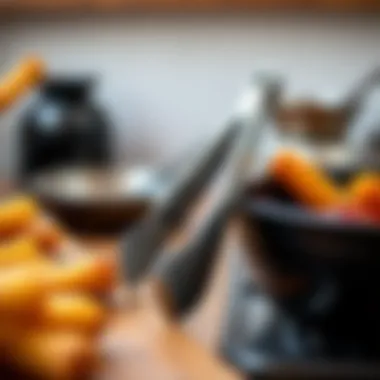
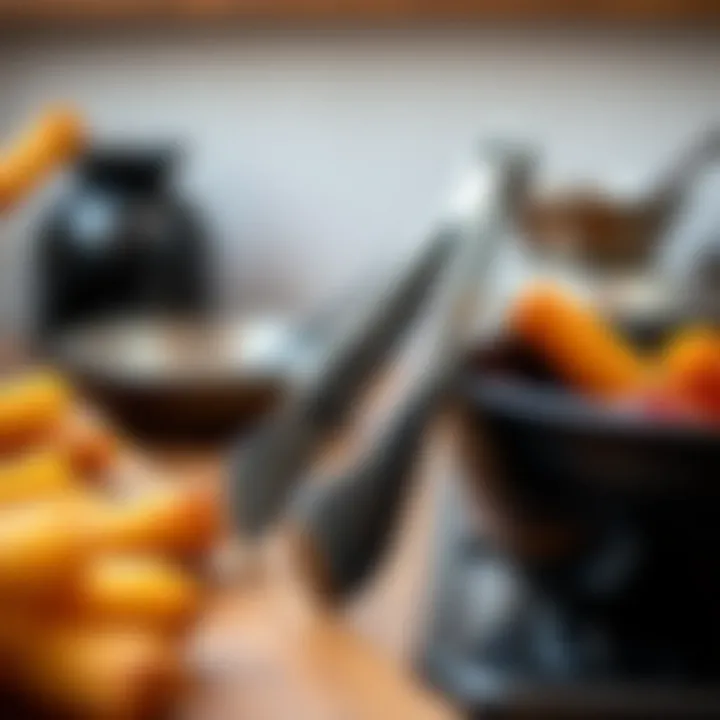
Different materials require varied levels of care. Understanding this can make a considerable difference in the longevity of your tongs. Tongs made of silicone, for instance, are pretty forgiving and can usually withstand the dishwasher's rigors. However, tongs made of wood or bamboo demand more attention.
- Key Characteristic: Wooden tongs can dry out, leading to cracks if not properly cared for.
- Unique Feature: It’s imperative to apply mineral oil occasionally to prevent drying, ensuring they remain functional and presentable.
Conversely, stainless steel tongs are often quite resilient but can be prone to rust if left wet for extended periods.
- Advantages: Durable and generally resistant to heat.
- Disadvantages: Requires immediate drying after washing to prevent corrosion.
Understanding these nuances could save you the heartache of having to replace your tongs frequently.
Storage Recommendations
Proper storage is often dismissed in the conversation about maintenance but is equally crucial. Tongs that are tossed haphazardly into a drawer may get tangled or even damaged. A simple solution is to use a designated space – perhaps a dedicated utensil drawer or a magnetic strip. This allows for easy access and ensures that they stay in good condition.
- Consideration: Avoid nested stacking to prevent wear on non-stick surfaces.
Using utensil holders can also help keep them upright and prevent grime accumulation. Keeping tongs clean not only aids in prolonging their life but also maintains kitchen hygiene, pivotal for any home cook. A little attention goes a long way.
Practical Applications in the Kitchen
Understanding how to properly use tongs in various cooking scenarios can significantly enhance your culinary experience. Tongs are not just tools; they are essential partners in the kitchen that allow for precise movements and facilitate multitasking. In this section, we will explore the versatile roles that tongs play across different cooking methods—making them indispensable for any kitchen.
Grilling and Barbecuing
When it comes to grilling, tongs are your best friend. They provide the necessary leverage to flip and rotate meats, vegetables, and other grill items without piercing them. This is especially important since piercing can release juices and flavor, which are what we want to keep locked in.
Using tongs on the grill allows for a safe distance between you and the heat source, reducing the risk of burns. Opt for tongs with long handles for better reach. Also, silicone-ended tongs are an excellent option here since they won’t damage non-stick surfaces and are heat-resistant. Make sure to clean your tongs after each use; this prevents cross-contamination between different types of food.
"Using proper utensils can elevate your grilling game from ordinary to extraordinary."
Stir-Frying and Sautéing
In the fast-paced world of stir-frying, efficiency is key. Tongs come into play here by allowing you to toss ingredients quickly without turning your pan into a battleground. The design of tongs makes it easy to grab a handful of veggies or proteins while ensuring everything is well-mixed and heated uniformly.
Consider traditional bamboo tongs for this technique; they manage heat well and are gentle on your pan's surface. However, if you need a little more grip while stirring, a decent set of stainless steel tongs can do wonders. They provide sturdiness and are less likely to slip out of your hand while flipping contents in the pan. Keep an eye on your cooking; stir-frying requires attention, and a quick flick of the wrist with tongs can make quite a difference.
Serving and Plating
After the cooking comes the art of serving and plating, where tongs again steal the show. Whether you're serving a delicate piece of fish or a hefty slice of roast, tongs offer precision in presentation. They help you control the amount and placement of food on the plate, turning a simple meal into a visually appealing feast.
Using tongs for serving allows everyone at the table to take what they fancy, reducing mess and maintaining the integrity of your carefully prepared dishes. For this purpose, consider using longer tongs that can easily reach across a table or serving platter. A set with rubberized grips can prevent slipping, ensuring that you keep your dishes intact as you transfer them.
When done right, using tongs can transform your kitchen skills, making tasks easier while enhancing your overall cooking experience. Indeed, knowing when and how to use this tool is half the battle in becoming a more effective cook.
Environmental Considerations and Sustainability
Sustainability is not just a trendy buzzword; it's an essential part of modern cooking and kitchenware choices. When it comes to selecting tongs for non-stick pans, considering the environmental impact can guide us towards options that benefit both the planet and our culinary ventures. The kitchen is often seen as the heart of the home, and we can make conscious choices here that ripple outwards, contributing to a more sustainable future.
Material choices in kitchen utensils can play a significant role in reducing environmental impact. One might think, "How much can a pair of tongs really matter?" But, when viewed through the lens of sustainability, the right materials can lead to less waste and more responsible cooking practices.
Sustainable Materials for Tongs
Bamboo
Bamboo has become a preferred material in the realm of sustainable kitchen utensils, including tongs. This grass grows rapidly, requiring minimal water and without the need for pesticides. One of the main characteristics that sets bamboo apart is its strength. Unlike other woods, bamboo is surprisingly durable and less prone to splitting, making it a reliable option for high-heat cooking.
A unique feature of bamboo tongs is their natural non-stick quality. They glide easily against the surface of non-stick pans without causing scratches. This not only preserves the longevity of your cookware but also means that you're using a tool that's friendly to your environment. However, it's important to note that while bamboo is a stellar option, it does require proper care. If not treated well, bamboo can absorb moisture, which may lead to warping or mold.
Recycled Plastics
Recycled plastics are another innovative solution for tongs designed for non-stick cookware. By repurposing materials that would otherwise become landfill waste, these tongs contribute to reducing the amount of plastic pollution. The key characteristic of recycled plastics is their versatility. They can be molded into various shapes and sizes, allowing for ergonomic designs that fit perfectly in the hand.
What makes recycled plastics appealing is not only their eco-friendly aspect but also their affordability. However, there are some drawbacks. The durability of recycled plastic can vary significantly based on manufacturing processes. Some cheaper options might not withstand high heat or rigorous usage, which could lead to more waste in the long run. Thus, when opting for tongs made from recycled materials, it's crucial to choose brands with a reputation for quality and durability.
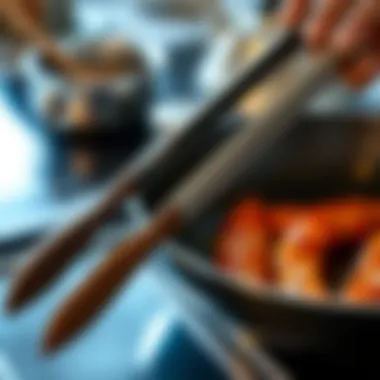
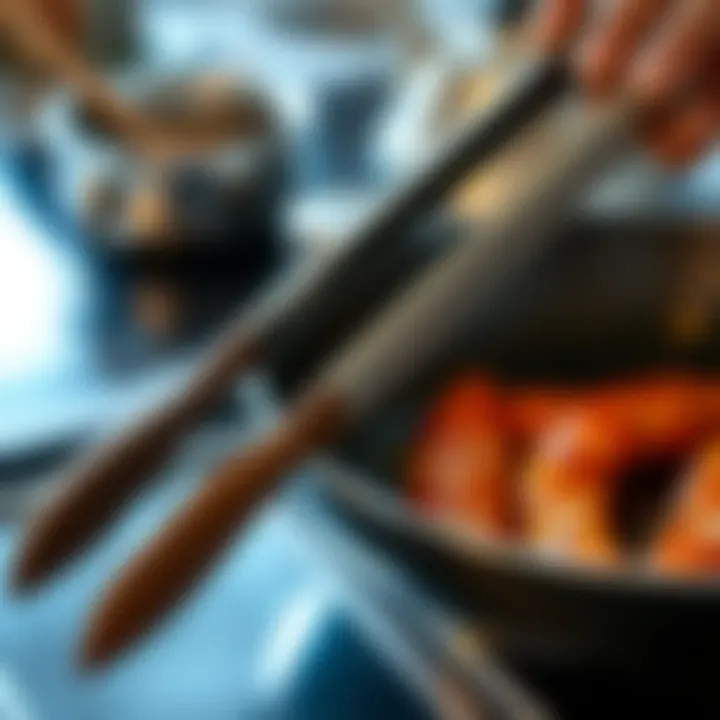
Reducing Kitchen Waste
Making a conscious effort to reduce kitchen waste can enhance the sustainability of your cooking practices. From choosing the right tools to simpler habits like composting your food scraps, every small step counts. One straightforward way to incorporate sustainable decisions into your kitchen routine is by opting for multi-purpose tools. For instance, selecting tongs that can also function for turning and serving can reduce the number of utensils you need, cutting down on plastic or metal waste.
Additionally, consider how you store and maintain your utensils. Proper care and maintenance extend the life of your kitchen tools, reducing the frequency with which you need replacements. But responsible habits don't stop with the tools; they can also be applied to food. Using fresh ingredients and creatively repurposing leftovers can minimize waste significantly and ensure that you're making the most of what you have at home.
Choosing the Right Brand
When it comes to kitchen tools, particularly tongs for non-stick pans, the brand you choose is pivotal. Selecting a reputable brand can make all the difference in not only durability but also the cooking experience itself. A good brand often reflects a commitment to quality, which can lead to safer, more efficient cooking. Investing in well-known brands can save you from future frustrations like melting handles or poorly designed grips that don't perform well in the heat of the moment.
So what should be considered when choosing the right brand? In addition to reputation, factors like customer reviews, warranty options, and material sources hover in the background. Understanding these aspects can arm you with the knowledge needed to make an informed decision that suits your cooking needs.
Brand Reputation and Quality
Brand reputation often acts as a compass guiding consumers to make wise purchase decisions. Companies like OXO, Calphalon, and Cuisinart are recognized for delivering products with consistent quality. These brands have weathered the test of time, and consumers generally view them as reliable sources.
It’s often noted that a good brand cultivates trust. They stand by their products—this can include offering generous warranties that keep you covered in case of defects. You might’ve heard someone say, "You get what you pay for," and in many cases, this rings true. Higher prices usually correlate with better materials and innovative features, allowing users to have a more seamless experience.
Moreover, a brand’s reputation is usually built on user feedback. Checking customer reviews on platforms like Reddit or Amazon can reveal insights on product performance and longevity. If a specific product garners complaints about its suitability with non-stick cookware, it might be wise to steer clear.
Price vs. Performance
Let's face it: cooking tongs come in all shapes and sizes, and you might find a range of prices that can be puzzling. However, understanding price versus performance adds another layer of depth when deciding on a brand. The truth is, you don't always need to break the bank, but opting for the cheapest option can lead to regret later. Some brands might offer lower-priced tongs, and while they may seem budget-friendly, they could lack the performance needed to tackle non-stick surfaces effectively.
A smarter approach might be to calculate cost-per-use. If a pair of tongs will last five years versus another that lasts just one, the upfront cost of the higher-quality option might actually be lower in the long run. Not worth saving a few bucks, right?
Ultimately, brands offering mid-range prices usually strike a balance between affordability and performance. Brands that score well in both customer satisfaction and durability are often the sweet spot for the average cook. A well-rounded brand not only provides great performance but reassures users when exploring culinary adventures, even if it means slightly more out of pocket.
"Choices in kitchen tools can take your cooking from mundane to magnificient; quality matters!"
User Reviews and Recommendations
In today’s fast-paced world, diners and cooks alike have turned to tongs not as mere utensils, but as integral partners in preparing delightful dishes. Understanding the pulse of how these tools perform across varied kitchens can empower potential buyers. User reviews and recommendations often rise to the forefront of a thoughtful purchasing decision. They illuminate firsthand experiences and shed light on both the benefits and potential pitfalls, creating a tapestry of insights that can help guide choices.
When considering tongs for non-stick pans, delving into customer feedback is key. It serves as a collective voice of the kitchen community, touching on elements such as durability, material efficiency, and functional design. These reviews often reflect shared pain points; for instance, a common critique might focus on how a pair of tongs fails to grip food securely or may be scratching the surface of cookware. On the flip side, many positive reviews celebrate a product that excels at tossing salads without becoming a sticky mess or flipping grilled vegetables seamlessly.
"The importance of real user experience can’t be understated. It’s like peering behind the curtain to see how products hold up in the real world."
Choosing tongs isn't merely about selecting a convenient tool—it's about finding a companion that will stand up to the demands of the kitchen.
Analyzing Customer Feedback
Customer feedback goes a long way in shaping our understanding of tongs for non-stick pans. It’s essential to recognize patterns in reviews. Some specific aspects to consider include:
- Performance Over Time: Are users noticing fraying or wearing out sooner than expected? High turnover might indicate low durability.
- Material Compatibility: Reviewers frequently mention how the tongs interact with non-stick coatings. Is there any indication of wear on their pans?
- Ease of Use: Many reviews express whether the tongs are comfortable to hold during extended periods of food prep. Do hands tire quickly, or can users maintain grip without hassle?
Navigating these elements creates a nuanced perspective that goes beyond marketing collateral. When reading reviews, think of them not just as opinions, but as critical evaluations shaped by real-life cooking scenarios.
Expert Opinions
Turning to experts for opinions can also offer significant value. Culinary professionals and kitchen designers often test various types of tongs under controlled conditions, providing insights that might not emerge in consumer reviews.
- Quality and Design: Experts can weigh in on the engineering of tongs, such as how a certain shape can improve functionality or user experience. The angle of a lifting head might work splendidly for one type of food, while facing a challenge with another.
- Safety Standards: Professional chefs often adhere to strict guidelines regarding kitchen tool safety. They can advise on which materials might be safer to use and less likely to react with non-stick coatings.
- Innovative Solutions: Expert recommendations can introduce lesser-known brands or designs that meet high standards. Sometimes a little-known silicone brand may outperform a household name, grabbing attention due to a unique feature.
In short, marrying user reviews with expert insights creates a robust foundation for making an informed purchase. This dual approach ensures that homeowners, designers, and culinary enthusiasts alike can identify the best tongs for their non-stick pans, tailoring their choices to suit their cooking styles.
Ending and Final Thoughts
In our exploration of tongs specifically crafted for non-stick pans, we’ve navigated through various considerations. Understanding the materials, types, and practical applications of these kitchen tools is crucial for any cooking enthusiast. Choosing the right tongs not only enhances your cooking experience but also protects your investments in non-stick cookware, ensuring that the surface remains intact and functional over time.
Summary of Key Points
- Materials Matter: The choice of material affects not just the durability but also the safety of using tongs on non-stick surfaces. Silicone and wood are preferred for their protective qualities.
- Design and Functionality: Ergonomically designed tongs provide a better grip and greater ease of use, which translates into a more enjoyable cooking experience.
- Care and Maintenance: Proper cleaning and storage extend the life of your tongs. Hand washing is recommended for most materials, ensuring they remain in top condition.
- Sustainability: Opting for eco-friendly materials like bamboo or recycled plastics aligns with a kitchen ethos that values environmental health.
- User Feedback and Brands: Taking the time to read reviews ensures that you choose tongs that meet your expectations both in performance and durability.
"Investing in the right tools is investing in quality cooking outcomes."
Encouraging Thoughtful Choices in the Kitchen
Ultimately, the choices we make in the kitchen reflect our priorities and values. When selecting tongs for non-stick pans, it’s wise to think critically about the purpose they will serve and how they fit within the broader context of our cooking habits. Consider brands that focus on quality and sustainability; their products often stand the test of time, providing better value in the long run. Furthermore, engaging in conversations about tools and methods on forums like reddit.com can offer insights and ideas that may not be immediately evident.
Cultivating an awareness of how tools affect cooking will lead to a more mindful kitchen practice. As homeowners, designers, or culinary enthusiasts, thoughtful choices not only enhance personal satisfaction but can also set a standard for quality in the kitchen realm. In an era where cooking is both an art and a science, investing in the right tools, like tongs, adds finesse to your craft.















